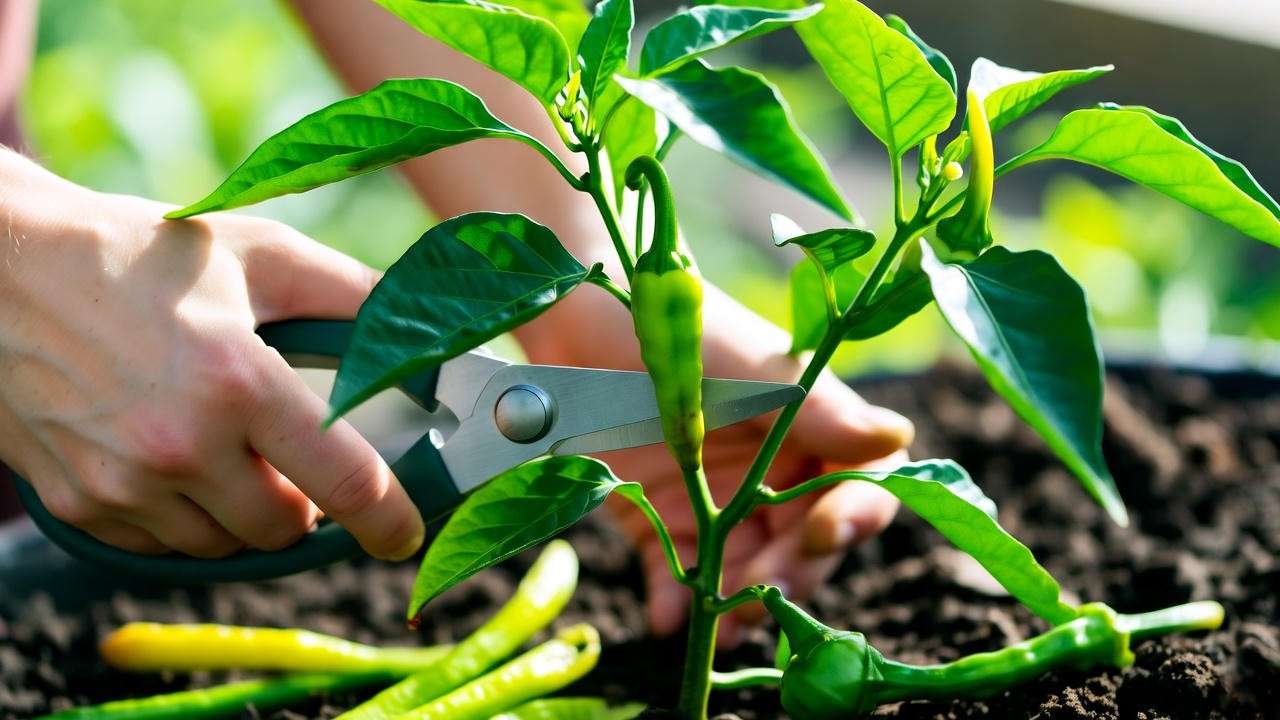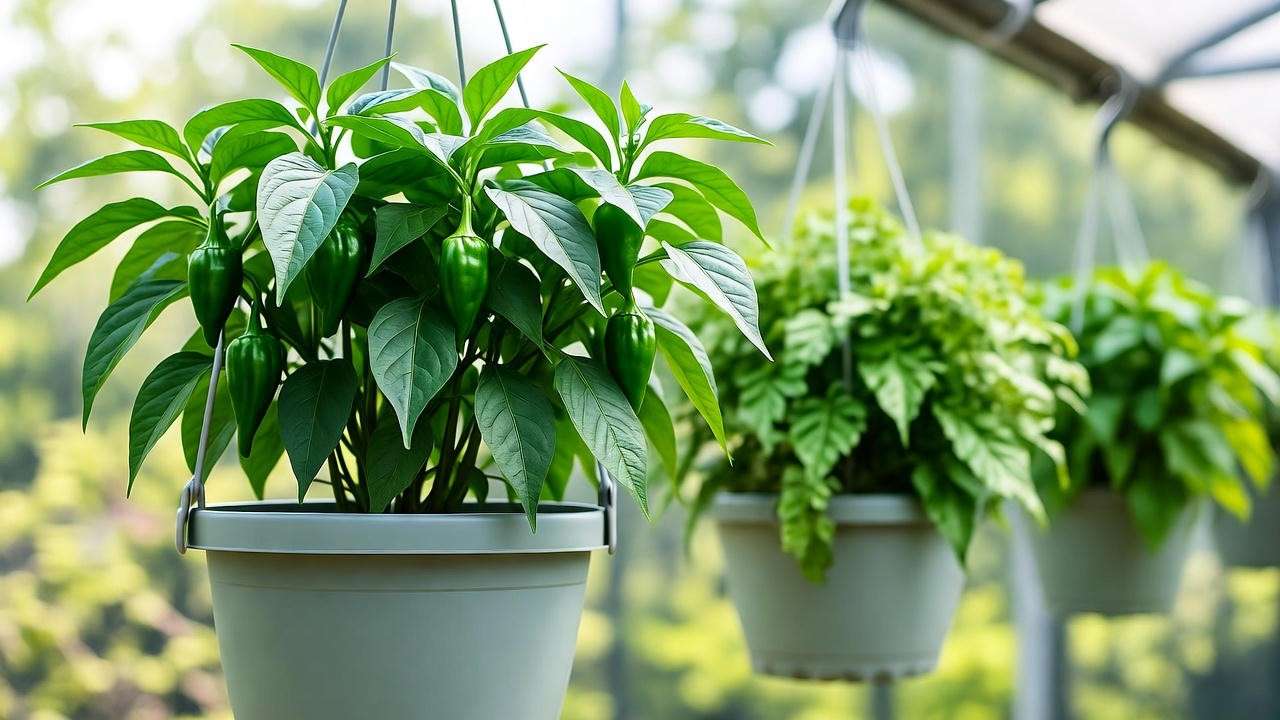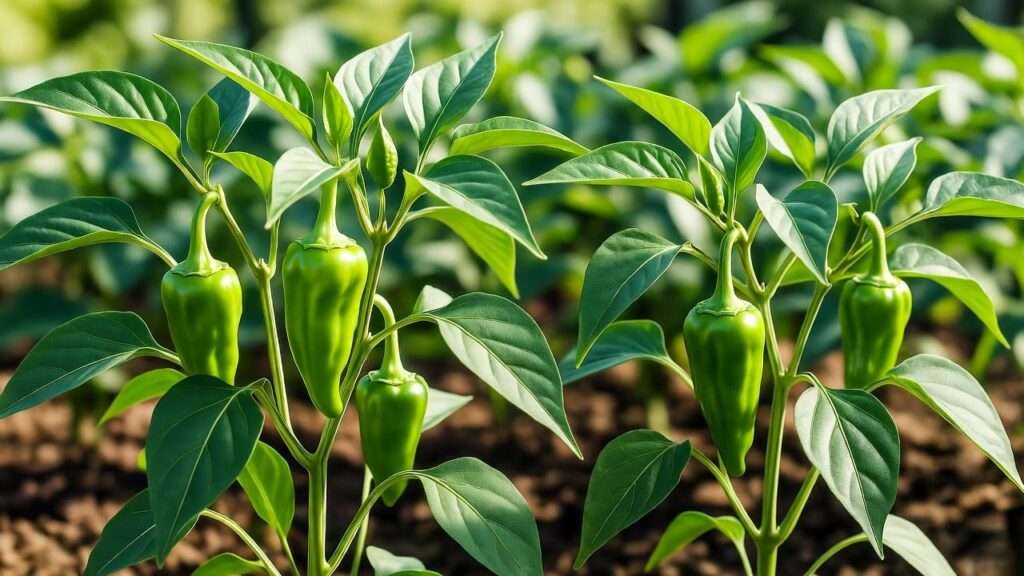Imagine biting into a perfectly blistered shoshito pepper, its mild, smoky flavor bursting with just a hint of spice—grown right in your own backyard! Shoshito pepper plants are the rising stars of home gardening, beloved for their vibrant green fruits, culinary versatility, and beginner-friendly cultivation. Whether you’re a seasoned gardener or just starting out, growing shoshito pepper plants can transform your garden and kitchen. In this comprehensive guide, you’ll uncover expert tips to cultivate healthy shoshito peppers, troubleshoot common issues, and enjoy a bountiful harvest. Backed by horticultural expertise and practical insights, this article will empower you to grow flavorful peppers with confidence! 🌞
1. What Are Shoshito Pepper Plants? 🌶️
Understanding the Shoshito Pepper
Shoshito peppers, or Capsicum annuum ‘Shishito,’ are a Japanese heirloom variety celebrated for their unique flavor and charmingly wrinkled appearance. Originating in East Asia, these peppers typically grow to 3–4 inches long, starting green and ripening to red. With a Scoville heat range of 50–200, most shoshitos are mild, though about one in ten surprises with a spicy kick! Their earthy, slightly sweet taste makes them a favorite for roasting, grilling, or tossing into stir-fries.
Why They’re Special: Shoshito peppers are a culinary darling, featured in trendy restaurants and home kitchens alike. Their compact plants and high yields make them a top choice for gardeners.
Why Grow Shoshito Peppers at Home?
Growing shoshito pepper plants offers multiple benefits:
- Ease of Growth: Perfect for beginners, these plants thrive in gardens, containers, or even indoors.
- Versatility: Their compact size (2–3 feet tall) fits small spaces like balconies or patios.
- Culinary Appeal: From appetizers to gourmet dishes, shoshitos elevate any meal.
Expert Insight: “Shoshito peppers are a game-changer for home gardeners,” says Dr. Emily Tanaka, a horticulturist with 15 years of experience in pepper cultivation. “Their forgiving nature and bold flavor make them a must-grow.”
2. Getting Started: Preparing to Grow Shoshito Pepper Plants 🌿
Choosing the Right Environment
Shoshito pepper plants thrive in warm, sunny conditions. Here’s how to set them up for success:
Climate and Temperature Needs
- Ideal Temperature: Shoshitos prefer 70–85°F (21–29°C) during the day, with nights above 60°F (15°C).
- Sunlight: Aim for 6–8 hours of direct sunlight daily. Partial shade may reduce yields.
- Cold Climates: In cooler regions, use grow lights or a greenhouse to extend the growing season. A south-facing window works for indoor setups.
Soil Requirements
Healthy soil is the foundation of thriving shoshito pepper plants. Use:
- Well-Draining Soil: A loamy mix with a pH of 6.0–6.8 is ideal. Test soil with a pH kit for accuracy.
- Organic Matter: Amend with compost or aged manure to boost nutrients.
- Container Gardening: Choose a high-quality potting mix with perlite or vermiculite for drainage. A 5-gallon pot is perfect for one plant.
Selecting Seeds or Seedlings
Where to Source Quality Shoshito Seeds
Purchase seeds from reputable suppliers like Baker Creek Heirloom Seeds, Johnny’s Selected Seeds, or local organic nurseries. Opt for non-GMO, heirloom varieties to ensure authentic flavor and robust genetics.
Tip Box: Top 3 Seed Suppliers for Shoshito Peppers
- Baker Creek Heirloom Seeds – Wide selection of heirloom shoshitos.
- Johnny’s Selected Seeds – High germination rates and organic options.
- Burpee – Reliable for beginners with detailed growing guides.
Starting from Seeds vs. Seedlings
- Seeds: Affordable and offer more variety. Start indoors 6–8 weeks before the last frost. Soak seeds in warm water for 24 hours to boost germination (85% success rate). Plant ¼ inch deep in seed trays with a heat mat (75–80°F).
- Seedlings: Faster but pricier. Choose healthy, vibrant seedlings from a trusted nursery, avoiding leggy or yellowing plants.
3. Planting Shoshito Pepper Plants: Step-by-Step Guide 🌱
When and How to Plant
Timing for Planting
Plant shoshito pepper plants outdoors after the last frost, typically in spring (April–May in USDA zones 9–11). Soil temperatures should be at least 65°F (18°C). For indoor gardening, start seeds anytime with proper lighting.
Planting Techniques
- Spacing: Space plants 18–24 inches apart to ensure airflow and prevent disease.
- Depth: Plant seedlings at the same depth as their nursery pot. For seeds, cover lightly with ¼ inch of soil.
- Containers: Use a 5-gallon pot with drainage holes. Fill with a mix of 60% potting soil, 20% compost, and 20% perlite.

Watering and Initial Care
Watering Best Practices
- Frequency: Water deeply when the top inch of soil feels dry (every 2–3 days in hot weather).
- Method: Use drip irrigation or water at the base to avoid wetting foliage, which can lead to fungal issues.
- Consistency: Keep soil moist but not waterlogged to prevent root rot.
Supporting Young Plants
- Staking: Use bamboo stakes or small cages for support, especially for container plants.
- Protection: Shield seedlings from wind or pests with row covers or cloches during the first 2–3 weeks.
Case Study: Sarah, a Seattle balcony gardener, grew shoshito peppers in 5-gallon pots using a simple trellis. By following a consistent watering schedule and using organic compost, she harvested 50 peppers per plant in her first season!
4. Caring for Shoshito Pepper Plants: Pro Tips for Thriving Growth 🌞
Nutrition and Fertilization
Choosing the Right Fertilizer
- Organic Options: Fish emulsion or seaweed extract provides balanced nutrients.
- Synthetic Options: Use a 5-10-10 NPK fertilizer to support fruiting. Apply every 2–3 weeks during the growing season.
- Application: Dilute liquid fertilizers per package instructions and apply to moist soil to avoid root burn.
Common Nutrient Deficiencies
- Nitrogen: Yellowing lower leaves. Correct with compost tea or blood meal.
- Potassium: Weak stems or poor fruiting. Add wood ash or greensand.
- Calcium: Blossom end rot (dark spots on fruit). Use crushed eggshells or gypsum.
Pruning and Maintenance
Pruning for Productivity
- When: Prune when plants reach 12–18 inches tall to encourage bushier growth.
- How: Remove suckers (small shoots between main stems and branches) and dead leaves with clean shears.
- Benefits: Increases airflow, reduces disease risk, and boosts fruit production.

Pest and Disease Management
- Common Pests:
- Aphids: Spray with neem oil or introduce ladybugs.
- Spider Mites: Increase humidity and use insecticidal soap.
- Whiteflies: Use yellow sticky traps.
- Diseases:
- Blossom End Rot: Caused by calcium deficiency or inconsistent watering. Correct with calcium supplements and steady irrigation.
- Powdery Mildew: White coating on leaves. Treat with a baking soda spray (1 tsp per quart of water).
Expert Tip: Plant marigolds or basil near shoshito peppers to deter pests naturally. Their vibrant blooms also add beauty to your garden! 🌼
5. Harvesting Shoshito Peppers: Timing and Techniques 🍴
When to Harvest
Identifying Ripeness
- Green Peppers: Harvest at 3–4 inches for a mild, grassy flavor (60–70 days from transplant).
- Red Peppers: Allow peppers to ripen fully for a sweeter, slightly spicier taste (80–90 days).
- Signs of Readiness: Firm, glossy peppers with vibrant color. Avoid soft or shriveled fruits.
Harvesting Tips
- Tools: Use pruning shears to cut peppers, leaving a small stem to avoid damaging the plant.
- Frequency: Harvest every few days to encourage continuous fruiting. A single plant can yield 50–100 peppers per season!

Storing and Using Your Harvest
Storage Best Practices
- Refrigeration: Store fresh shoshitos in a perforated plastic bag in the fridge for up to 2 weeks.
- Freezing: Blanch peppers for 2 minutes, then freeze in airtight bags for up to 6 months.
- Drying: String peppers and air-dry in a warm, ventilated area for use in spice blends.
Culinary Uses for Shoshito Peppers
Shoshitos shine in simple dishes:
- Blistered Shoshito Peppers: Toss in olive oil, sear in a hot skillet, and sprinkle with sea salt.
- Stuffed Peppers: Fill with cream cheese or quinoa for a gourmet appetizer.
- Infused Oils: Blend dried shoshitos into olive oil for a spicy kick.
Recipe: Blistered Shoshito Peppers
- Ingredients: 1 lb shoshito peppers, 2 tbsp olive oil, flaky sea salt.
- Instructions: Heat oil in a cast-iron skillet over high heat. Add peppers and cook for 5–7 minutes, turning until blistered. Sprinkle with salt and serve hot. Serves 4 as an appetizer.
6. Troubleshooting Common Shoshito Pepper Problems 🐛
Growing shoshito pepper plants is rewarding, but challenges can arise. This section tackles common issues with practical solutions to keep your plants thriving. Whether it’s stunted growth, pests, or lackluster yields, we’ve got you covered with expert-backed advice.
Why Aren’t My Shoshito Peppers Growing?
Environmental Issues
Shoshito pepper plants are sensitive to their environment. Here are common culprits and fixes:
- Overwatering: Soggy soil leads to root rot. Check drainage and water only when the top inch of soil is dry. Use pots with drainage holes for container plants.
- Underwatering: Wilting or drooping leaves signal thirst. Water deeply, ensuring moisture reaches the roots. Mulch with straw or bark to retain soil moisture.
- Insufficient Sunlight: Less than 6 hours of direct sun stunts growth. Relocate containers to sunnier spots or supplement with grow lights (12–16 hours daily for indoor plants).
- Temperature Extremes: Below 60°F (15°C) or above 90°F (32°C) slows growth. Use row covers in cool weather or shade cloth during heatwaves.
Solution: Monitor soil moisture with a meter and use a thermometer to track garden conditions. Adjust care based on local weather patterns.
Pest and Disease Challenges
Persistent pests or diseases can derail your shoshito crop. Here’s how to diagnose and treat them:
- Aphids: Tiny green or black insects clustering on new growth. Spray with a mix of 1 tsp neem oil, 1 tsp dish soap, and 1 quart water every 3 days until gone.
- Spider Mites: Fine webbing and yellow speckled leaves. Mist plants daily to increase humidity and apply insecticidal soap weekly.
- Blossom End Rot: Dark, sunken spots on pepper bottoms. Ensure consistent watering and add crushed eggshells to the soil for calcium.
- Powdery Mildew: White patches on leaves. Improve air circulation by pruning and apply a baking soda spray (1 tbsp baking soda, 1 tsp soap, 1 gallon water).
Pro Tip: Regularly inspect plants early in the morning when pests are active. Early intervention prevents widespread damage.
Boosting Yield and Flavor
Maximizing Pepper Production
Low yields can frustrate gardeners. Try these strategies:
- Hand-Pollination: For indoor or greenhouse plants, use a small paintbrush to transfer pollen between flowers. This boosts fruit set by up to 30%.
- Regular Harvesting: Picking peppers encourages plants to produce more. Aim to harvest every 3–5 days during peak season.
- Avoid Over-Fertilization: Excess nitrogen causes leafy growth at the expense of fruit. Stick to a balanced 5-10-10 fertilizer and follow the recommended schedule.
Enhancing Flavor
The flavor of shoshito peppers depends on growing conditions:
- Soil Quality: Nutrient-rich soil enhances sweetness. Incorporate compost or worm castings every 4–6 weeks.
- Sunlight: Full sun intensifies flavor compounds. Ensure plants get at least 6 hours of direct light daily.
- Watering: Consistent moisture prevents bitterness. Avoid letting soil dry out completely between waterings.
FAQ Section:
- Q1: Why are my shoshito peppers spicy sometimes? A: About 10% of shoshito peppers develop mild heat due to environmental stress, like high temperatures or water fluctuations. Harvesting green peppers reduces the chance of spiciness.
- Q2: Can I grow shoshito peppers indoors year-round? A: Yes! Use grow lights (12–16 hours daily) and maintain 70–80°F temperatures. Choose compact varieties for easier indoor management.
- Q3: How long does it take for shoshito peppers to mature? A: From transplant, green peppers take 60–70 days, while red peppers need 80–90 days.
- Q4: What’s the best way to prevent pests on shoshito pepper plants? A: Companion plant with marigolds or basil, inspect regularly, and use organic sprays like neem oil as a preventative measure.
7. Advanced Tips for Shoshito Pepper Success 🌟
Ready to take your shoshito pepper plants to the next level? These advanced techniques will help you maximize yields, experiment with varieties, and grow like a pro.
Scaling Up Your Shoshito Garden
Growing in Small Spaces
Shoshito peppers are perfect for urban gardeners with limited space:
- Vertical Gardening: Use trellises or hanging planters to grow shoshitos vertically. This saves space and improves airflow.
- Container Hacks: Stackable pots or grow bags allow multiple plants in tight spaces. Ensure each plant has a 5-gallon container for root growth.
- Hydroponics: Shoshitos thrive in hydroponic systems like nutrient film technique (NFT). Hydroponics can increase yields by 20–30% but requires investment in equipment.
Example: Urban gardener Mia in Chicago grew 10 shoshito plants on her apartment balcony using vertical grow bags. With proper care, she harvested 200 peppers in one season!

Overwintering Shoshito Plants
In colder climates, overwintering extends your plant’s life:
- Pruning: Before the first frost, cut back plants to 6–8 inches, removing all leaves and fruit.
- Indoor Care: Move potted plants indoors to a sunny window or under grow lights. Maintain 65–75°F and water sparingly.
- Spring Revival: Gradually reintroduce plants to outdoor conditions in spring after hardening off for 7–10 days.
Experimenting with Varieties
Exploring Shoshito Hybrids
While traditional shoshito peppers are beloved, hybrids offer unique traits:
- Fushimi Peppers: A close cousin with a milder flavor and longer shape.
- Shishimai: A hybrid with smaller, sweeter fruits ideal for snacking.
- Sources: Check Seed Savers Exchange or local seed swaps for rare cultivars.
Cross-Pollination Risks
Growing multiple pepper varieties? Prevent cross-pollination to maintain pure shoshito seeds:
- Isolation: Space different pepper types 50–100 feet apart or use mesh bags over flowers.
- Timing: Stagger planting to avoid overlapping flowering periods.
- Seed Saving: Collect seeds from isolated plants and store in a cool, dry place for up to 3 years.
Expert Insight: “Shoshito peppers are evolving with new hybrids that offer exciting flavors,” says Dr. Maria Lopez, a pepper breeder at Cornell University. “But preserving heirloom varieties ensures their unique character endures.”
Conclusion: Grow Your Own Shoshito Peppers with Confidence! 🎉
Growing shoshito pepper plants is a delightful journey that combines ease, flavor, and garden beauty. From selecting the perfect seeds to mastering care techniques, you now have the tools to cultivate vibrant, flavorful peppers at home. Whether you’re roasting them for a party or experimenting with new varieties, shoshitos bring joy to both gardeners and foodies. Start today—grab your seeds, prepare your soil, and watch your garden thrive! Share your shoshito growing tips or favorite recipes in the comments below. 🌶️













